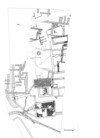The suggestion that Pforzheim may have been the capital of an otherwise unknown civitas rests on the fact that it was named on a milestone from Friolzheim. It is not clear, however, whether it may not have been the executive centre of a different type of administrative district, such as an imperial domain. The Latin name suggests a harbour. The town began c. 90 AD but, because of the small scale of the excavated remains, little can be said about its development, although the occupied area was markedly extended around the middle of the 2nd century.
The Roman settlement eventually reached a length of c. 600m. Initially it only occupied the north bank of the Enz but in the middle of the 2nd century, occupation extended onto the south bank as well. The road network cannot be reconstructed.
Extent of the Roman settlement |
Plan of the stone buildings and find locations |
No remains of public buildings or large building complexes are known.
Along a road to the north of the Enz, stone buildings with cellars are known.
A few surviving remains suggest timber predecessors. Excavations on the Kappelhofplatz
have revealed occupation in both the timber and stone periods.
 Plan of the excavated remains on the Kappelhofplatz
Plan of the excavated remains on the Kappelhofplatz
A large area of settlement containing two rows of stone buildings was found
south of the Enz on the site of what is now the city hospital. Three 10-13m
wide strip buildings with cellars were found to the north of the road whilst,
to its south, two long rectangular buildings with cellars were excavated, which
probably served as store buildings and had cellars under part of their area.
![]() Plan of the city hospital excavations, with possible plot boundaries
Plan of the city hospital excavations, with possible plot boundaries
Visible remains and Museum
Roman remains and finds are on display at the Archäologischen Schauplatz Kappelhof
in Pforzheim.
F. Damminger, Pforzheim: Vom römischen vicus zur markgräflichen Residenz. Acta Praehistorica et Archaeologica 34, 2002, 241-257.
A. Dauber in: Die Römer in Baden-Württemberg (Stuttgart3 1986) 477-480.
K. Kortüm, Portus-Pforzheim. Untersuchungen zur Archäologie und Geschichte in römischer Zeit. Quellen und Studien zur Geschichte der Stadt Pforzheim 3 (Sigmaringen, 1995).
K. Kortüm, Portus/Pforzheim, "Furt, Fähre" oder "Hafen"? Archäologisches Korrespondenzblatt 25 (1995) 117-125.
E. Schallmayer, Der Kappelhofplatz - Ausgrabungen im ältesten Siedlungsteil Pforzheims. Archäologische Ausgrabungen in Baden-Württemberg 1989, 139-143.
E. Schallmayer, Fortsetzung der Ausgrabungen auf dem Kappelhofplatz von Pforzheim. Archäologische Ausgrabungen in Baden-Württemberg 1990, 141-145.
E. Schallmayer, Abschluß der archäologischen Untersuchungen am
Kappelhofplatz in Pforzheim. Archäologische Ausgrabungen in Baden-Württemberg
1991 (1992), 135-139.